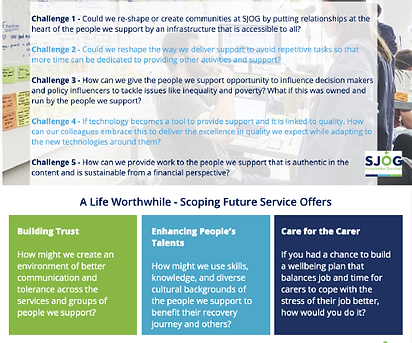
Trailblazer Programme
Enhancing innovation and creativity at SJOG Hospitaller Services UK
Type of work: Workshop design and facilitation
Duration: 4 Sessions delivered in 2 years
Team: SJOG Hospitaller Services UK - Opportunities team
My strengths: Workshops design, activity planning, and delivery
Impact:
- More colleagues aware and involved in service modeling activities in the charity.
- Enhanced use of creative tools for innovation and strategic decisions.
- 3 projects piloted with 1 implemented successfully and with funding secured.
The Trailblazer Programme is a creativity initiative designed to develop social innovation projects within SJOG Hospitaller Services UK. SJOG UK is a charity that works in four key social care areas: homelessness, modern-day slavery and trafficking, disabilities, and older religious communities.
The programme responded to the need of increasing innovation in social care services to achieve more impactful results for communities and attract funders. Recognising the valuable insights of colleagues, we saw the potential to involve them early in the process to develop new solutions and concepts for piloting and incorporating into service models.
As the service designer in the Opportunities Team, my role was to develop this creativity programme for colleagues across the charity.
Creating the Trailblazer Programme
My approach typically involves using the design thinking framework as a base. For the Trailblazer Programme, it guided the design and structuring of the workshops and activities, and then it was integrated into the programme itself.

1. Understanding the learning needs
Through conversations with EMT and Service Managers, I identified that the goal of the creativity workshops was to help colleagues explore and develop ideas they encountered in their roles but lacked the experience, time, or tools to do it. Additionally there was a wider organisational need for innovation is service models that helps

4. Identifying challenges to tackle in the workshop
To ensure a productive ideation space and avoid time-consuming research during sessions, I conducted the discovery phase beforehand, presenting key insights and challenges to work on. I carefully selected different challenges for each of the 4 cohorts, initially based on learnings from the first workshop and subsequently to align with the organisational strategy. This preparatory research was a significant aspect of my work. (see defining the challenges below)

2. Creating a pensum
I structured the programme using the Double Diamond framework, focusing the two-day residential workshops on the defining phase. This decision addressed the need for colleagues to explore and develop their ideas, with subsequent piloting and scaling of selected concepts over the next 3-6 months. I briefed a colleague on the structure, and together we finished deciding what the activities will look like on the session.

5. Delivering the first cohort
The first residential workshop involved colleagues submitting ideas they wanted to develop. Eight colleagues attended and worked individually, using various creativity, research, and quick prototyping tools. I facilitated the workshop with support from a team colleague. At the end of the two days, each person pitched their ideas to the Opportunities team. We invited experts from academia to support the sessions, act as judges, and provide feedback on the ideas.

3, Choosing the tools and activities
Having decided the workshops would focus on the defining phase, I gathered tools for ideation and concept creation, such as "crazy 8's," "thinking hats," and quick prototyping methods. I also included engaging activities like the "impossible invention challenge" (e.g., create a paper bicycle) to enhance creative thinking and create a fun environment for developing ideas.

6. Iterating and delivering cohorts 2, 3 and 4
Running Trailblazer 1 provided us with valuable learnings (see lessons learnt below) that helped us make decisions to run the three upcoming sessions more effectively. Based on colleagues' feedback and observations during the two days, we made adjustments such as working in groups rather than individually and simplifying certain steps of the session to allow more time for completion.
Defining the challenges
Trailblazer 1: Participants submitted their project ideas on the application, leading to the definition of challenges based on common themes of the proposals.
Trailblazer 2 and 3: These sessions took a different approach. I conducted research across the 4 areas supported by SJOG, resulting in the definition of three challenges reflecting the research findings detailed in "A Life Worthwhile - Scoping Future Service Offers Revisited.”
Trailblazer 4: Tailored for the operations team, this session's challenge was defined with the Chief Operation Officer's perspective on the things that needed to be addressed within her team.

Lessons learnt in the making
Thinking styles
After facilitating the first workshop, I realised the importance of accommodating different thinking styles in the upcoming sessions. As a designer with background in design thinking and service design tools, I was somewhat overconfident and assumed everyone would immediately understand and engage with these methodologies. Recognising this gap, I simplified the methods for subsequent sessions and closely monitored participant engagement while maintaining the workshop's core objectives.
Better planning next steps
Limited resources and colleagues' availability made it difficult to put the concepts into practice after the residential workshop. While the ideas showed potential, they required additional research and work beyond the two-day session to be truly useful. It was very ambitious to want to pilot and implement the projects without a dedicated team to do so. This experience highlighted the importance of thorough planning, setting achievable goals, and pre-assessing resources carefully to ensure project success.
Evolving
The Trailblazer programme provided colleagues with an excellent opportunity to learn new methods, think outside the box, and challenge themselves. Although the programme was iterated four times within the two years it was funded, we concluded that it still needed simplification. Moving forward, without the funding, we created a simple online creativity course. This course retained the essence of the Trailblazer programme and offered colleagues the same benefits at a lower cost and with less stress and work required after the sessions.

Colleagues presenting their rationale for a creative task of an impossible invention.

Colleagues building a prototype for a creative task of an impossible invention.

Diagram to explain the system design in the ideation phase

Colleagues presenting their rationale for a creative task of an impossible invention.
The Programme
The program consists of a two-day residential event for participants to engage in design thinking activities, creating innovative solutions to address challenges and enhance service users’ experience in SJOG's services and follow up on potentially implementing some of the concepts.
As the Opportunities Team, our role is to provide colleagues across the organisation with tools, encouragement, and resources (including funding, time, and space) to develop their ideas and bring their expertise from working in the organisation and their understanding of the people we support.
The program involves the following phases:
-
Designing: Participants attend a workshop with structured activities aimed at fostering creativity and generating new ways to support communities across SJOG and/or address social problems.
-
Piloting: The best ideas have the opportunity to be piloted with support from the Opportunities Team for idea development and guidance from external experts in academia and industry.
-
Measuring: The impact of the pilots will be measured with support from the Opportunities Team.
-
Scaling: The Opportunities Team collaborates with the fundraising team to secure funding for scaling successful pilots.

High level framework for Trailblazer Programme. The residential sessions cover the Design phase. Rest of phases over a period of 3-6 months.

Above: challenges for session 1 Below: challenges for sessions 2 and 3

Above: ice breaker creative challenges Below: crazy 8's activity

High level framework for Trailblazer Programme. The residential sessions cover the Design phase. Rest of phases over a period of 3-6 months.
Successfully implemented Trailblazer project
Belong
Culturally aware welcome packs for Ukrainian refugees.
1 - Concept
"Belong" concept was created during the first Trailblazer session.
It was originally a welcome pack for women refugees with essential items and connections to supporting networks.
2 - Piloting big scale
In the process of piloting we got the opportunity to work with Ukrainian refugees through the Homes for Ukraine scheme, as SJOG joined as a recognised provider.
Homes for Ukraine scheme aligned with the Belong’s objectives for refugees and support networks. Some slight changes in the items included in the packs were made to adjust to men and children as well.
3 - Building
Funding was secured to buy all the items and SIM cards were acquired with a partner phone provider.

4 - Details
Belong bags included a 10 step guide on what to do on arrival. It was a gesture of welcome for people who are lost.
5 - Delivery
I coordinated logistics for packing and delivering the bags to guests in their arrival to host’s homes.
6 - Reach
We supported 150 people with Belong.


7 - Impact
We collected feedback through a survey. Ukrainian guests showed appreciation for the Belong bags and highlighted the some of the most useful items like UK current adaptors.
Thoughtful acts of kindness like the Belong bags makes them feel that people are there to support them.
“Thank you very much for the welcome box! It came quickly, and the feeling was a pleasant surprise!” - Anonymous woman with family